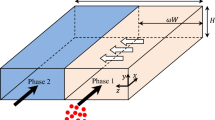Abstract
Liquid–liquid flow profiles are central to the operation of microfluidic devices in a range of applications. We recently demonstrated a multi-stream solvent extraction (SX) chip that combines high-surface-to-volume ratios and volumetric throughput. Here, we study these flow profiles in detail using numerical simulations, with consideration of different boundary conditions. The two liquids differ in viscosity, modelled on platinum (aqueous) and extractant (organic) phases, and the position of the liquid–liquid interfaces (and therefore surface/volume and phase ratios) can be controlled by adjustment of flow rates. The prediction of the position of the interface requires the solution of the governing equations of fluid mechanics. The volume of fluid (VOF) method was used to simulate the dynamics of the organic and aqueous phases to reveal stable flow profiles. This experimentally validated computational model with the root-mean-square deviation of about 11 µm will be useful for simulation of microfluidic SX design and operation, particularly where process intensification is sought through scale-out.
Graphic abstract







Similar content being viewed by others
References
Anderson J (1995) Computational fluid dynamics. McGraw-Hill Education, New York
Bahiraei M et al (2018) Thermal performance and second law characteristics of two new microchannel heat sinks operated with hybrid nanofluid containing graphene–silver nanoparticles. Energy Convers Manag 168:357–370
Balaban NQ et al (2004) Bacterial persistence as a phenotypic switch. Science 305(5690):1622–1625
Bashir S et al (2011) Simulations of microfluidic droplet formation using the two-phase level set method. Chem Eng Sci 66(20):4733–4741
Behjati HE et al (2017) Modelling of immiscible liquid–liquid systems by Smoothed Particle Hydrodynamics. J Colloid Interface Sci 508:567–574
Brackbill J et al (1992) A continuum method for modeling surface tension. J Comput Phys 100(2):335–354
Ciceri D et al (2014) The use of microfluidic devices in solvent extraction. J Chem Technol Biotechnol 89(6):771–786
De Menech M (2006) Modeling of droplet breakup in a microfluidic T-shaped junction with a phase-field model. Phys Rev E 73(3):031505
Dhouib K et al (2009) Microfluidic chips for the crystallization of biomacromolecules by counter-diffusion and on-chip crystal X-ray analysis. Lab Chip Miniat Chem Biol 9(10):1412–1421
Ducry L, Roberge DM (2005) Controlled autocatalytic nitration of phenol in a microreactor. Angew Chem 117(48):8186–8189
Hirt CW, Nichols BD (1981) Volume of fluid (VOF) method for the dynamics of free boundaries. J Comput Phys 39(1):201–225
Hua J et al (2007) Numerical simulation of microdroplet formation in coflowing immiscible liquids. AIChE J 53(10):2534–2548
Huebner A et al (2008) Microdroplets: a sea of applications? Lab Chip 8(8):1244–1254
Karnik R et al (2008) Microfluidic platform for controlled synthesis of polymeric nanoparticles. Nano Lett 8(9):2906–2912
Kashani MN et al (2016) Explicit numerical simulation-based study of the hydrodynamics of micro-packed beds. Chem Eng Sci 145:71–79
Kolar E et al (2016) Microfluidic solvent extraction of rare earth elements from a mixed oxide concentrate leach solution using Cyanex® 572. Chem Eng Sci 148:212–218
Kralj JG et al (2007) Integrated continuous microfluidic liquid–liquid extraction. Lab Chip 7(2):256–263
Kriel FH et al (2017) A multi-stream microchip for process intensification of liquid–liquid extraction. Chem Eng Technol 40(6):1184–1189
Malecha ZM, Malecha K (2014) Numerical analysis of mixing under low and high frequency pulsations at serpentine micromixers. Chem Process Eng 35(3):369–385
Maruyama T et al (2004) Liquid membrane operations in a microfluidic device for selective separation of metal ions. Anal Chem 76(15):4495–4500
Nagrath S et al (2007) Isolation of rare circulating tumour cells in cancer patients by microchip technology. Nature 450(7173):1235–1239
Ngo I-L et al (2015) A numerical study on the dynamics of droplet formation in a microfluidic double T-junction. Biomicrofluidics 9(2):024107
Patankar S (1980) Numerical heat transfer and fluid flow. Taylor & Francis, Milton Park
Priest C et al (2011) Microfluidic extraction of copper from particle-laden solutions. Int J Miner Process 98(3):168–173
Priest C et al (2012) Microfluidic solvent extraction of metal ions and complexes from leach solutions containing nanoparticles. Chem Eng Technol 35(7):1312–1319
Sivasamy J et al (2011) An investigation on the mechanism of droplet formation in a microfluidic T-junction. Microfluid Nanofluid 11(1):1–10
Song H, Ismagilov RF (2003) Millisecond kinetics on a microfluidic chip using nanoliters of reagents. J Am Chem Soc 125(47):14613–14619
Stone HA, Kim S (2001) Microfluidics: basic issues, applications, and challenges. AIChE J 47(6):1250–1254
Valenzuela F et al (2005) Removal of copper ions from a waste mine water by a liquid emulsion membrane method. Miner Eng 18(1):33–40
Whitesides GM (2006) The origins and the future of microfluidics. Nature 442(7101):368–373
Xu JH et al (2008) Enhancement of mass transfer performance of liquid–liquid system by droplet flow in microchannels. Chem Eng J 141(1):242–249
Yin C-Y et al (2013) Microfluidic solvent extraction of platinum and palladium from a chloride leach solution using Alamine 336. Miner Eng 45:18–21
Yu Z et al (2007) Experiment and lattice Boltzmann simulation of two-phase gas–liquid flows in microchannels. Chem Eng Sci 62(24):7172–7183
Zhou Z, Feng Y (2002) Microfluidics-related research and applications. In: MEMS/MOEMS technologies and applications, vol. 4928. International Society for Optics and Photonics, pp 190–198
Acknowledgement
This work was conducted (in part) using the ‘Design House’ facilities at the South Australia node of the Australian National Fabrication Facility (ANFF-SA), a company established under the National Collaborative Research Infrastructure Strategy to provide nano- and micro-fabrication facilities for Australia’s researchers. The authors thank the Government of South Australia, Anglo Platinum, and Johnson Matthey for support through the Premier Science and Industry Fund (IRGP38).
Author information
Authors and Affiliations
Contributions
MNK conducted the simulations. FHK, CB and CP refined the simulations by providing experimental data, parameters and observations. All authors contributed to the interpretation of results.
Corresponding author
Additional information
Publisher's Note
Springer Nature remains neutral with regard to jurisdictional claims in published maps and institutional affiliations.
Electronic supplementary material
Below is the link to the electronic supplementary material.
Rights and permissions
About this article
Cite this article
Navvab Kashani, M., Kriel, F.H., Binder, C. et al. Analysis of co-flowing immiscible liquid streams and their interfaces in a high-throughput solvent extraction chip. Microfluid Nanofluid 24, 19 (2020). https://doi.org/10.1007/s10404-020-2320-0
Received:
Accepted:
Published:
DOI: https://doi.org/10.1007/s10404-020-2320-0




